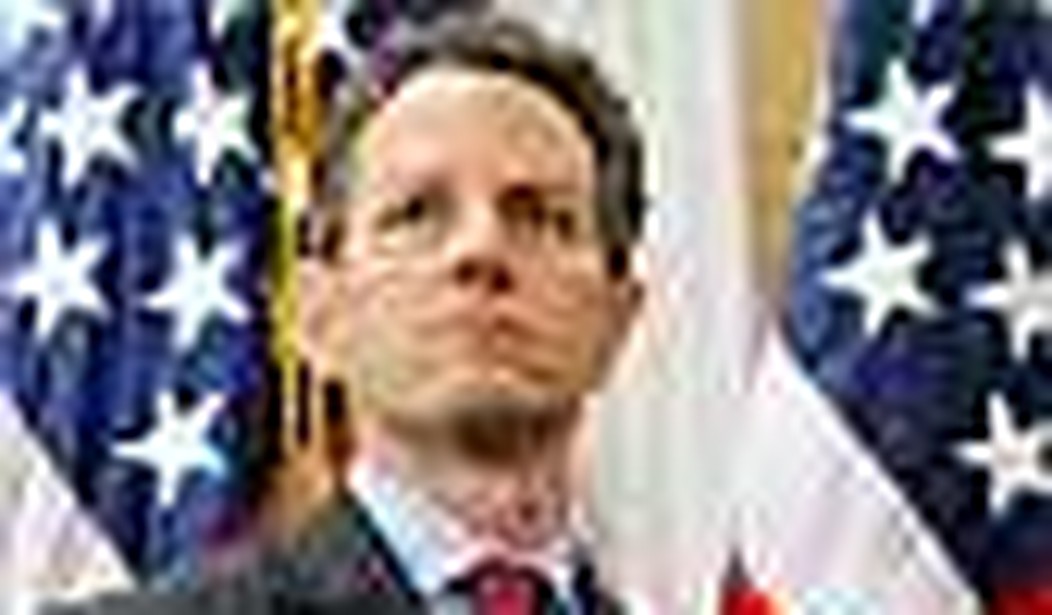The Obama administration’s new bank rescue plan is simultaneously a statement of faith in free markets and an acknowledgment of free market failings. The plan represents a “third way” between the first TARP giveaway to banks on the one side and private companies and the “stimulus” bill on the other.
Geithner’s plan is to utilize investors to affix a market price to toxic assets such as mortgage-backed securities, and then use government and investor money to purchase those assets in order to remove them from bank balance sheets. Investors will compete with one another to purchase toxic assets in an auction-type environment. The percentage of private investor money used in the purchase of these assets is small, somewhere on the order of 5-20%. The rest of the money will be from the government in form of loans or matching funds or a mix of both.
Some in the media have been calling this plan a “partnership” between private investors and the government. The term “partnership” is quite an exaggeration. Private investors are not “partners” if they are putting in 10-20% of the money and the government 80-90%. The plan attempts to turn Wall Street investors into honest consultants or secondaries acting on the government’s behalf by establishing an environment in which market forces will be at play, with mostly government money at risk. It does not establish a partnership in the sense that both partners are equally sharing the financial risk.
This plan is a carefully crafted, deliberate attempt to use government bailout money as efficiently as possible to remove toxic assets from bank balance sheets. Unlike with previous bailout attempts, Geithner has probably wargamed potential outcomes with various Wall Street investors in order to determine the ideal percentage of private investment required to obtain a fair market price for the government. Geithner is gambling that investors would be scared away from investing at all if they had to put a greater percentage of their own assets down in order to play ball.
The most important aspect of Geithner’s plan is not necessarily the details of the scheme but rather the increase in confidence in the market that this plan has already brought (the Dow jumped almost 7% on Monday). As confidence in the market increases, so does the value of the troubled assets that are weakening bank balance sheets and making banks nervous about new lending. Geithner’s calculated leaking of the plan for Wall Street to mull over last weekend was intentionally designed to prep the market for a strong week, which will further increase confidence in the plan and the market itself.
Many of the assets are mortgage-backed securities, and if confidence that the economy will improve increases, the value of those assets will increase because investors believe more homeowners will be able to make the mortgage payments that support those securities. The other market force at play is Geithner’s introduction of competing investors who are willing and able to buy these assets, which in turn will further increase the value of the assets on bank balance sheets. This will add to the overall certainty of the value of banks, whose stock value will then improve. We already saw this on Monday as Citigroup’s stock skyrocketed almost 20%. At some point the banks will feel comfortable enough with their balance sheets to lend again.
The biggest criticism of the plan is that the government is taking all the risk and trusting Wall Street to determine prices of toxic assets. This is stated most clearly in Paul Krugman’s Monday article, in which he states that the plan “in essence, assumes … that bankers know what they’re doing.” Krugman presumes that government bureaucrats know what they are doing to a greater degree than self-interested investors, which in turn exposes a deep distrust of the fundamentals of capitalism on the part of Mr. Krugman. The government taking the vast majority of the risk is now the critical element, as to date no investors have stepped forward in significant numbers with enough money to remove the toxic assets from bank balance sheets on their own.
The plan represents a significant improvement over the previous two largest attempts to right the system. Henry Paulson’s original plan for distribution of TARP money quickly degenerated into a free-for-all for influence peddling by politicians and billions and billions of dollars were distributed arbitrarily. Geithner’s plan is also a vast improvement over the staggeringly wasteful “stimulus” bill, which was a glittering monument to faith in government central planning and a national embarrassment whose destructive details continue to emerge. Paulson’ plan at least attempted to address the core issue of the day — the banking crisis — though it did so in a ham-handed, inefficient way. The worst part of the “stimulus” bill was that it did not address the central component of the crisis — the balance sheets of banks. Geithner’s plan directly addresses the balance sheet issue by leveraging market expertise with government resources, which is a reasonable compromise.
This plan will go further to stabilize the market than either the first TARP handouts or the “stimulus” bill, while using less money. Geithner puts a lot of faith in the invisible hand of the market — the very core of a capitalist’s worldview — and for this he should be commended.
Hopefully the combination of market expertise and government resources will pay off.









Join the conversation as a VIP Member